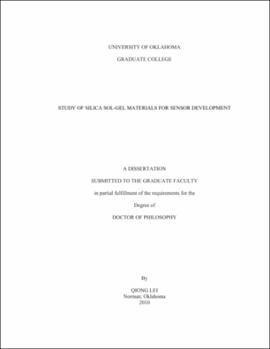| dc.contributor.advisor | Yip, Wai Tak | |
| dc.creator | Lei, Qiong | |
| dc.date.accessioned | 2019-04-27T21:38:04Z | |
| dc.date.available | 2019-04-27T21:38:04Z | |
| dc.date.issued | 2010 | |
| dc.identifier | 99364675802042 | |
| dc.identifier.uri | https://hdl.handle.net/11244/319217 | |
| dc.description.abstract | As a widely-explored subject for numerous applications, silica sol-gel has attracted | |
| dc.description.abstract | the attention of our group for sensor development. This study focused on pore surface | |
| dc.description.abstract | modification of two different types of silica sol-gel by post-grafting method, and | |
| dc.description.abstract | construction of stable silica hydrogel-like thin films. By monitoring the mobility and | |
| dc.description.abstract | photostability of rhodamine 6G (R6G) molecules in silica alcogel thin films through | |
| dc.description.abstract | single molecule spectroscopy (SMS), the guest-host interactions altered by | |
| dc.description.abstract | post-synthesis grafting were examined. Similar post-grafting method was then applied | |
| dc.description.abstract | to highly hydrated silica hydrogel monoliths; more efficient surface modification was | |
| dc.description.abstract | expected, because larger pore sizes in hydrogel provide higher accessibility of | |
| dc.description.abstract | organosilane reagents. During the study of post-grafting on alcogel thin film, a new | |
| dc.description.abstract | approach to produce stable silica hydrogel-like thin films was discovered. A lot of effort | |
| dc.description.abstract | has been made to improve the reproducibility of sample preparation, and the guest | |
| dc.description.abstract | loading capacity of silica hydrogel-like thin films. A prototype silica hydrogel-like thin | |
| dc.description.abstract | film pH sensor was also constructed and tested. | |
| dc.description.abstract | 12 | |
| dc.description.abstract | Understanding how guest-host interactions can be affected by silane modifications | |
| dc.description.abstract | is critical to sensor development. It helps tailoring the local environments inside silica | |
| dc.description.abstract | sol-gel matrix, so that higher guest loading, longer shelf-life, higher sensitivity and | |
| dc.description.abstract | faster response of silica gel based sensors could be achieved. Stable silica hydrogel-like | |
| dc.description.abstract | thin film with a thickness only around 200 nm, which to the best of our knowledge has | |
| dc.description.abstract | never been accomplished before, is expected to be a better substrate for sensing devices | |
| dc.description.abstract | that demand faster response than thick monoliths | |
| dc.format.extent | 208 pages | |
| dc.format.medium | application.pdf | |
| dc.language | en_US | |
| dc.relation.requires | Adobe Acrobat Reader | |
| dc.subject | Colloids | |
| dc.subject | Silica gel | |
| dc.subject | Ceramic materials | |
| dc.title | Study of Silica Sol-Gel Materials for Sensor Development | |
| dc.type | text | |
| dc.type | document | |
| dc.thesis.degree | Ph.D. | |
| ou.group | College of Arts and Sciences::Department of Chemistry and Biochemistry | |
